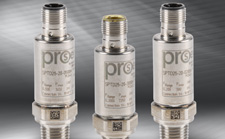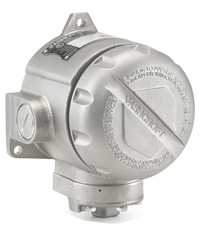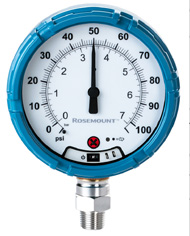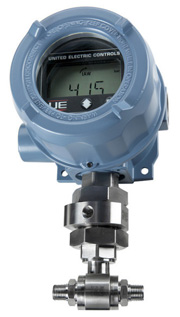- Products
Summary
Pressure transmitter

Units are available in 13 uniquely configurable standard ranges, covering 0–150 to 0–10 K psig or psis, along with a variety of electrical connections. Depending upon range, the model can withstand up to 1.5 times proof pressure (10 K psi range) and up to 5 times burst pressure (or 30 K psi, whichever is less). Typical applications for the model 386 flush-tip pressure transmitter include paint finishing systems, automotive and aerospace test stands, in-laboratory research and development, process pressure measurements, adhesives, sludge and slurries, and viscous media measurements.
Viatran, www.viatran.com
Series pressure transmitters

Gauge pressure is detected using a four-arm, active strain-gauge bridge incorporating highly stable resistors. The resistors are fused to a high-purity ceramic element. Changes in pressure on that element cause bridge voltage changes, conditioned by onboard processing electronics. The TPL series may be specifically configured for a wide range of pressure ports and electrical connections, to cover all typical installation requirements. Units are available in a choice of 14 unique standard pressure ranges (both BarG and psig), 20 unique 303-grade stainless-steel pressure port styles, and eight unique seal materials, including EPDM for potable water applications.
Additional options include a choice of a IP65-rated mini-DIN plug and socket or a IP6K9K-rated bayonet connector. U.K. Accreditation Service-accredited calibration is also optional.
TT Electronics, www.ttelectronics.com
Pressure transmitters

AutomationDirect, www.automationdirect.com
Explosion-proof pressure switch

Ashcroft, www.ashcroft.com
Turbine flowmeters

Hoffer Flow Controls, www.hofferflow.com
Wireless pressure gauge

The pressure gauges use piezoresistive sensor technology to deliver reliable pressure readings. With the flexibility to accommodate changing process conditions, the gauges also give up to 150 times more overpressure protection than traditional gauges. The field environment is safer with two layers of process isolation.
Bourdon tube gauges have traditionally been a mainstay for taking pressure readings in the field, but are limited to visual indication of process conditions when an operator is present. Bourdon tubes also use moving parts, which can break or wear over time due to use and vibration\, causing inaccurate readings or the process to spill.
The wireless pressure gauge eliminates common weak points by removing the components that inhibit the device from reporting and displaying pressure. It has up to a 10-year life, which reduces maintenance costs and time. The 4.5-inch gauge face provides visibility in the field.
Emerson Process Management, www.emersonprocess.com
HART 7 transmitters
The One series 1XTXSW HART-capable transmitters provide programmable switching functionality for industrial process monitoring applications. The transmitters integrate HART 7–compatible 4–20 mA output and two solid-state programmable relays for monitoring temperature or pressure in safety, alarm, and emergency shutdown applications.

The transmitters are especially suitable for hazardous and harsh monitoring conditions with temperature extremes and high pressures that rapidly change, exhibiting pulsations, water hammer and thermal cycling, and other wear-inducing conditions. Mechanical switches, which have more moving parts, are more susceptible to such trauma, which affects reliability and requires more maintenance. Integrating sensors and solid-state relays in an explosion-proof transmitter enclosure protects them from environmental stress. The HART programming capability makes it easier to configure and maintain both the sensor and the switch, remotely, avoiding the need to open the enclosure in Division 1 areas. The 1X line also has worldwide hazardous location approvals for Class I, Divisions 1 and 2 (Zones 0, 1, and 2).
United Electric Controls, www.ueonline.com
HART communicators
The company’s HART communicator kits for hazardous areas use the TAB-EX series of Android tablets. The kits include the tablet, a HART modem, and the DevComDroid DD-based smart communicator app for Android. The app is a fully functional HART communicator. The entire DD library from FieldComm Group is included and regularly updated with a subscription. The user can also add new DDs. The app can perform full configurations of valves, multivariable devices, and complex devices, such as radar level and Coriolis flowmeters.
There is a Bluetooth wireless interface between the HART modem and the tablet. All components are certified for use in hazardous areas. Hazardous areas covered include CSA (Class 1, Division 1), ATEX, and IECEx. There is also a Windows version for Class 1, Division 2 hazardous areas.
ProComSol, www.procomsol.com
High-res sensor
The DLHR series low-pressure sensors work in pressure ranges of 0.5–60 inH2O. An advanced ASIC performs error compensation internally. The sensors have either I2C or SPI output interfaces with 16/17/18-bit resolution and accuracy better than 0.25 percent FSS BFSL. They can operate at variable supply voltage from 1.68–3.6 V. Devices are available in 0.5, 1, 2, 5, 10, 20, 30, and 60 inH2O pressure ranges, gauge and differential. The sensors are suitable for medical devices associated with low pressure, portable devices, battery-operated devices, remote sensing, HVAC application, spirometry, instrumentation, respiratory machines, and industrial controls.
All Sensors Corporation, www.allsensors.com
Reader Feedback
We want to hear from you! Please send us your comments and questions about this topic to InTechmagazine@isa.org.


